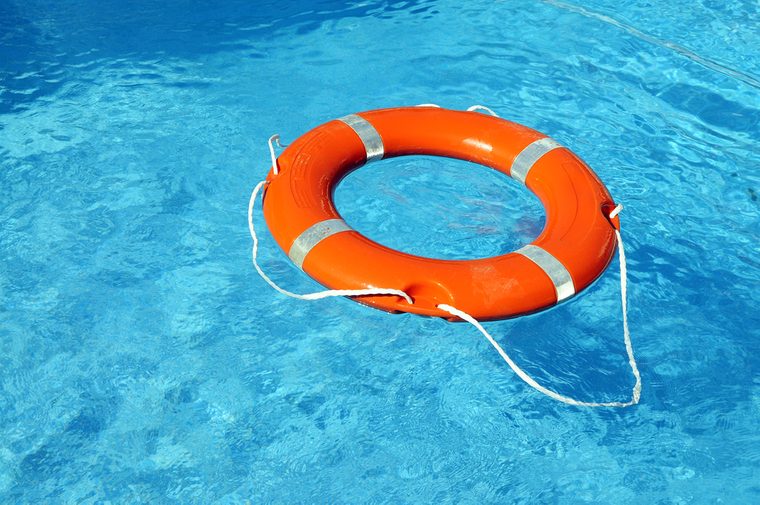Drowning doesn’t look like you expect
Drowning is the number one cause of injury-related deaths among young children according to the CDC, so it’s important to know how to spot it. You might imagine you’d notice someone failing about and screaming for help—but in reality, drowning is silent. According to a study from Safe Kids Worldwide and Nationwide’s Make Safe Happen program, “nearly half of parents say they think if a child was drowning nearby, they would hear him or her,” says pediatrician Marcee White, MD, medical advisor for Safe Kids Worldwide. “Instead, drowning is quick and quiet.” Young kids will show very little movement in their arms and legs, and may only have time to take a quick breath—not enough time or breath to scream—before they go under. “This all happens in a matter of minutes,” Dr. White says. Watch out for more silent but deadly signs of drowning.
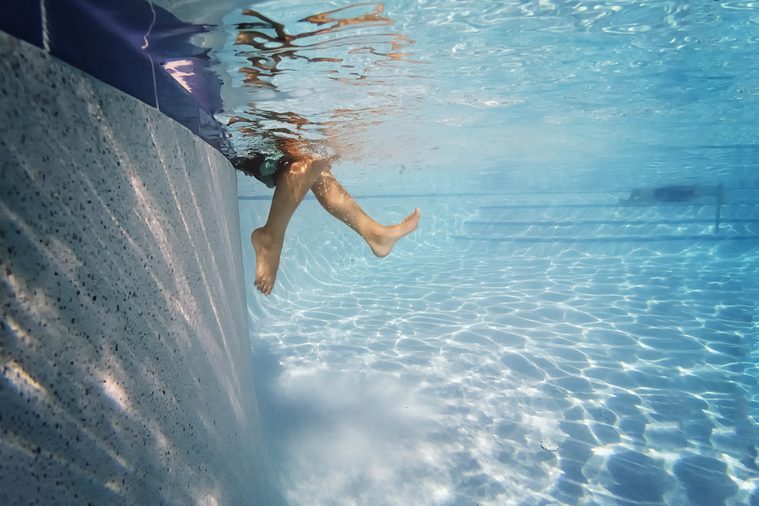
Not having a designated “water watcher”
You’re at a summer barbecue and the kids are playing happily in the pool, but each parent thinks someone else is paying attention—which means no one is. This is just one of the incredibly dangerous parenting moves even careful parents make by mistake. “It is very common in pool-party situations for everyone to assume that someone else is watching the pool,” says pool safety expert Eric Lupton, CEO of Life Saver Pool Fence. “Designate a water watcher who is responsible for doing nothing but watching the pool—not using the phone or socializing—and rotate water watchers every 10 to 15 minutes.” Dr. White advises actually handing the parent on duty a physical “Water Watcher Card” to make them doubly aware that they’re on duty until they pass the card—and responsibility—to the next person. Here’s a card that you can download and print out.
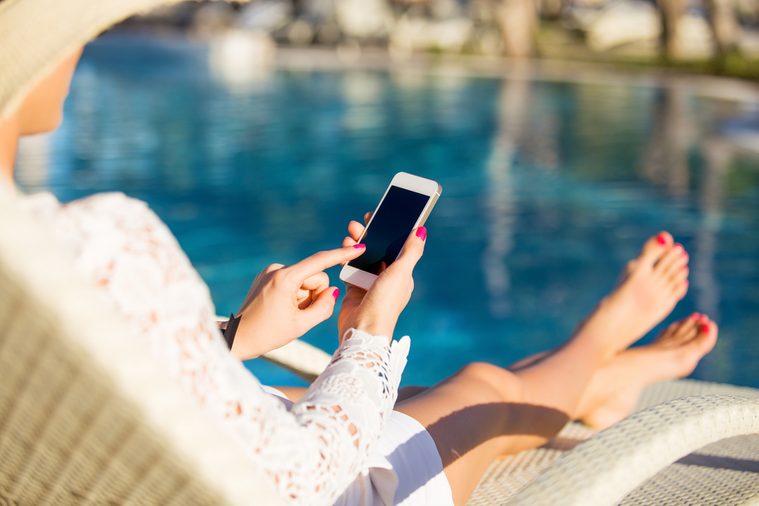
Texting
Home pools don’t usually have lifeguards—but even when you’re at a public pool, be sure that you or your children’s caregiver don’t rely solely on a lifeguard to watch the kids. “Before smartphones, there were other distractions at pools and beaches—reading books and magazines, talking to other parents,” Dr. White says. “It is all the same—distraction that may put a child at risk.” Be sure that you’re being vigilant, and create rules for babysitters who are watching your children at the pool, such as no cell phone use. Here are more crucial water safety tips lifeguards wish parents knew.
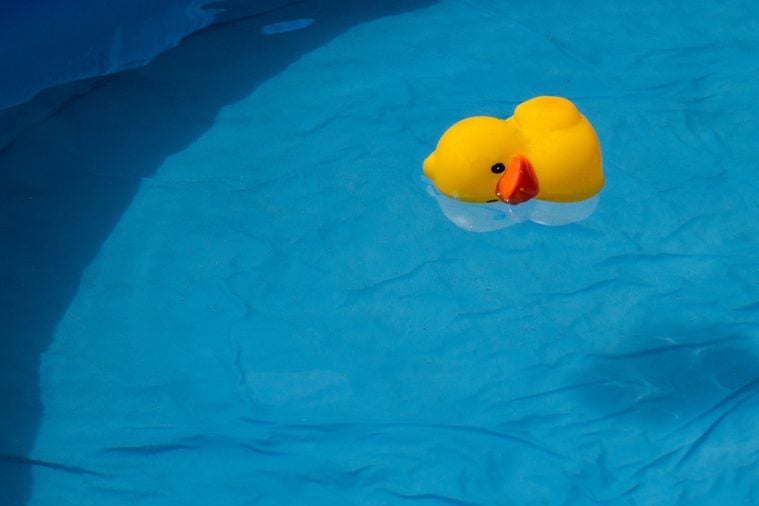
Breathing problems after swimming
You might hear terms like “dry drowning” or “secondary drowning” being bandied about, but Dr. White advises that they’re not given much credence by most medical organizations, despite what you may’ve heard: “There have been a lot of stories about kids who seemed perfectly fine after getting out of a pool, ocean, or lake and then, suddenly, as much as a day later, end up with breathing difficulties and die,” she says. “[The idea] is terrifying, but this kind of sudden ‘dry drowning’ with no prior symptoms just doesn’t occur.”
However, you should be on the lookout after a water rescue or any situation where you’ve aspirated water. “If after a water rescue, a child has an excessive or prolonged cough, fast or hard breathing, or is not breathing normally or ‘acting right,’ caretakers should also seek immediate medical attention,” Dr. White says.
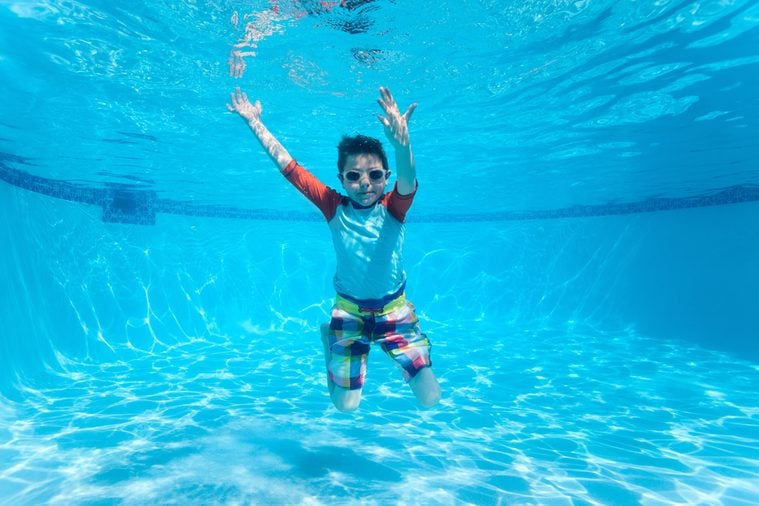
Kids who are risk-takers
Kids, especially boys, may engage in rough-housing in and around water, which may lead to injury. “The latest study from Safe Kids Worldwide and Nationwide’s Make Safe Happen program found that about 84 percent—or 8 out of 10 kids—who fatally drown in open water are males, and boys account for 68 percent of children and teens who fatally drown in pools,” Dr. White says. “Boys tend to be greater risk-takers than girls overall and are at higher risk of most types of injuries.” Shallow diving, aggressive dunking, holding-your-breath games, and other risky behaviors should be avoided among both boys and girls. In addition, don’t let kids run around the pool, where decks can be slippery. “Many pool deck companies offer surfaces that are less slippery and provide more traction,” Lupton says. Still, caution kids not to run, to avoid falls.
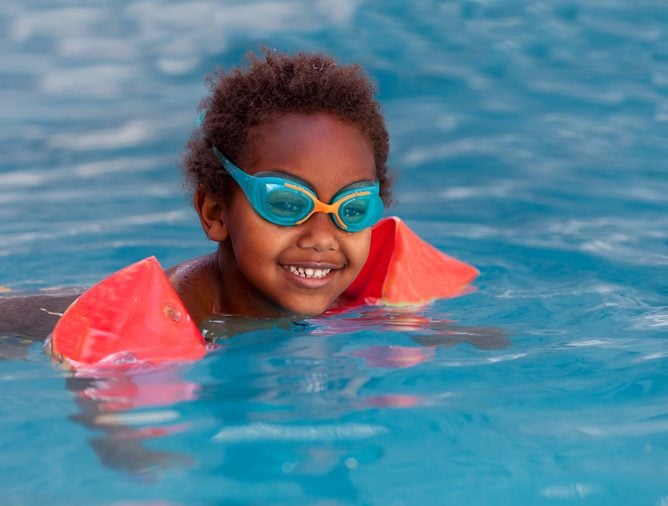
Relying on floaties
Do you know the surprising reason why lifeguards hate floaties? Floaties, “swimmies” and other flotation devices can give parents—and kids—a false sense of security. “Never assume that your child is safe using flotation toys like inner tubes, rafts, noodles, or other similar items,” says Nychelle Fleming, Pool Safely Campaign Lead for the U.S. Consumer Product Safety Commission. “They are not a replacement for a U.S. Coast Guard approved life vest, which is the safest option for children when they are in and around the water.” The real deals are officially called “personal flotation devices” or PFDs. “Families should make sure babies and little kids have a PFD with both a collar for head support and a head strap between the legs,” Dr. White says. But even with an approved PFD, don’t take your eyes off your child. In addition, swim lessons are crucial so kids actually learn to swim on their own. Don’t miss these true water rescue stories that will make you rethink how you swim.
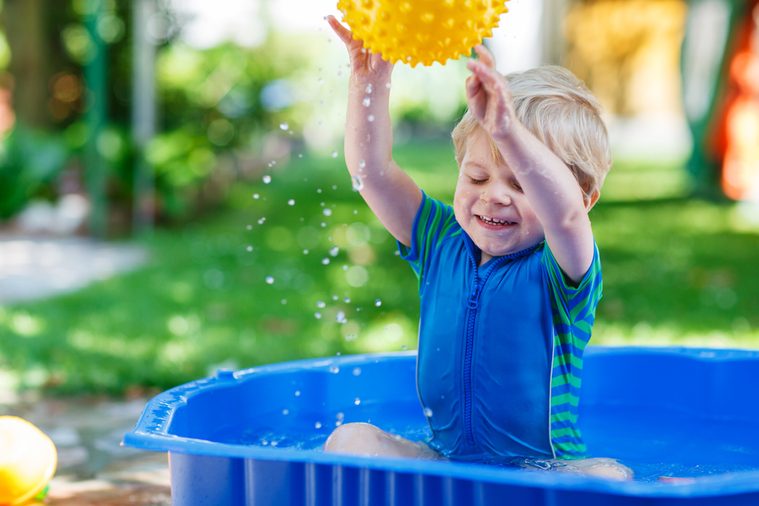
Kiddie pools
Your little ones will love that little blow-up pool, but just because it’s shallow doesn’t mean it isn’t dangerous. “The warm, shallow water in these pools [usually untreated tap water] can be the perfect breeding ground for water-borne infection,” Dr. White says. “They also pose a drowning danger, even if the water is shallow—a young child can drown in as little as two inches of water.” She advises ensuring children are never in the water unsupervised and emptying the pool after each use to prevent bacteria from growing. You should store your kiddie pool upside-down as well, so rainwater doesn’t collect in. If you’re making these pool hygiene mistakes, you could be making your kids sick.
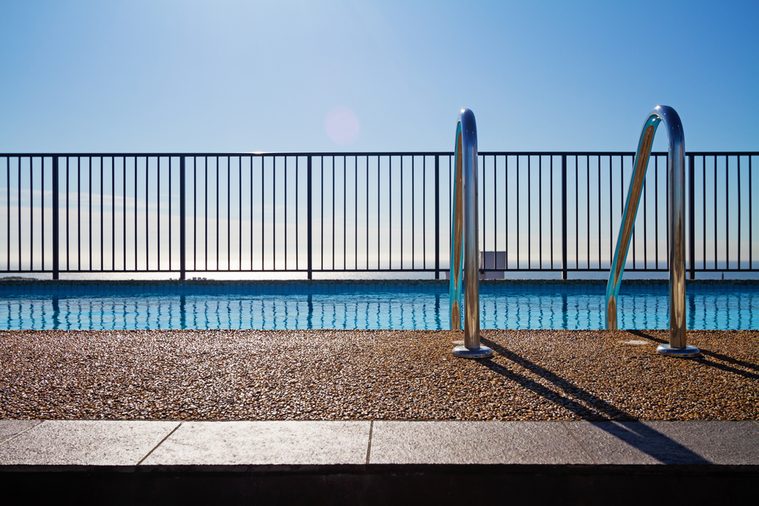
Unfenced pools
Backyard pools can be a delight, but they need to be fenced off (it’s the law in many areas). If you have young children, consider fencing off the pool itself, not just the yard; just remember a fence isn’t foolproof for many kids. “A pool fence is not a replacement for parent supervision,” Lupton says. “A persistent enough five-year-old, with enough time, can likely overcome any barrier. Definitely keep chairs and furniture away from the pool fence, and keep toys out of the pool area when the pool is not in use—so children are not incentivized to try and get in the pool fence.” He advises self-closing, self-latching gates instead of manual gates, with an unreachable latch at least 54 inches above the ground. Also, when visiting friends’ houses with pools, make sure your child can’t get outside without your knowledge—and should a child go missing, always check the pool first. Here’s more you’ll want to know on swimming pool safety.
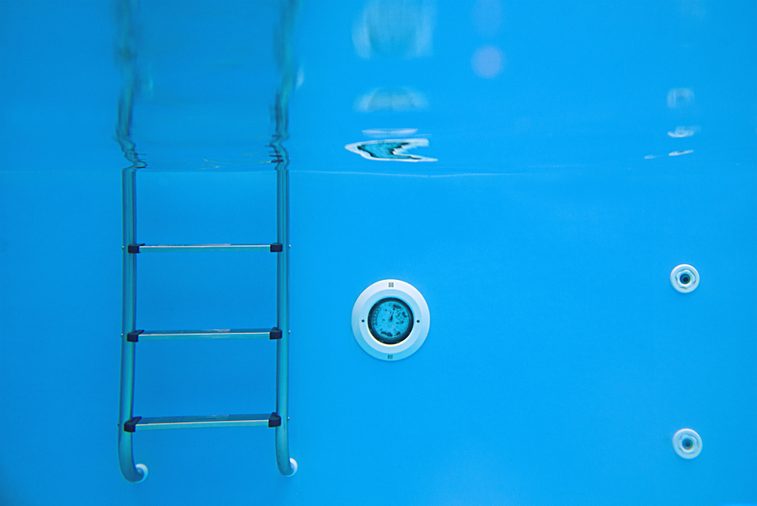
Ladders
You might think an above-ground pool is safe because children can’t easily fall in—but don’t underestimate a child’s curiosity. “Those with an above-ground or portable pool should put ladders away when adults are not present—to prevent children from gaining access,” Fleming says. “If ladders or stairs are not stored properly when the pool is not in use, children may climb or play on them and could easily slip and fall into the pool.” Find out more backyard dangers to avoid.
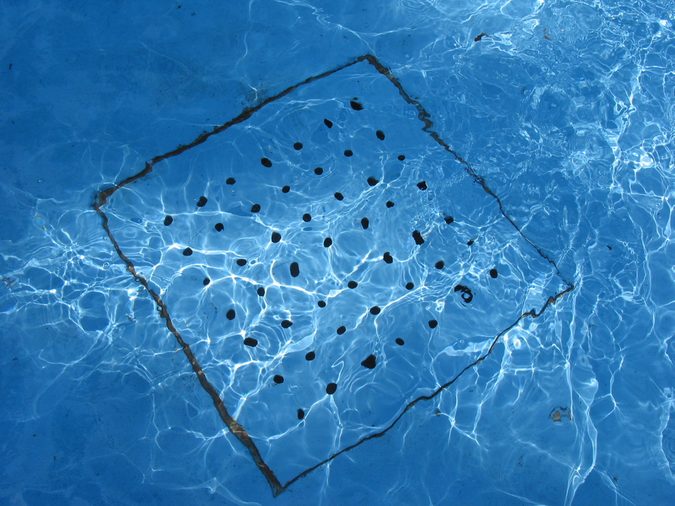
Drain covers
The suction of pool drains and filters can be a hazard. “Children should be taught to avoid pool drains, and it is important for homeowners to know how to shut off their pool pump in the event of an emergency,” Lupton says. “The suction from the drain will be too strong to pull someone off, so the only way to free them is by disabling the drain suction.” Recent laws surrounding drain manufacturing have helped to prevent drain entrapment deaths, but you should still be aware and keep kids away—especially if a drain cover is missing. “While these are mandated by federal law for public pools, private pools should have them as well,” Fleming says. “In addition to immediately replacing non-compliant covers, pool owners should always replace broken, loose, or missing drain covers, too.” Don’t miss these additional tools for pools every pool owner needs.
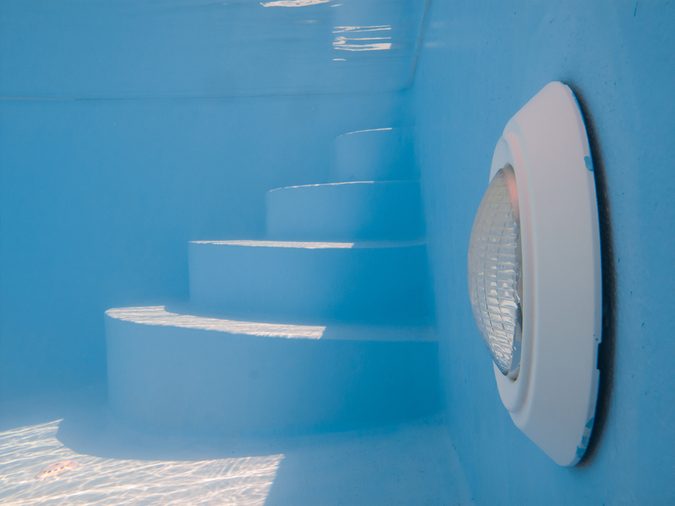
Electrical shock
You know that electricity and water don’t mix, but what about pool lights, sound system, and other electrical wiring in a pool area? “Make sure your pool light is regularly maintained. Old pool lights have been known to cause electrical accidents for swimmers,” Lupton says. Electricity is used to run pumps and heaters, and those also need to be maintained properly. Pool equipment should be supplied by ground fault circuit interrupters (GFCIs), Fleming says. In addition, “If using cord-and-plug connected devices such as radios and fans around the pool area, use a portable GFCI or plug them into a GFCI-protected circuit,” she says. “Keep all devices far away enough from the pool’s edge so that they are not accessible from the water.” Here are more hidden dangers in your home you should never ignore.
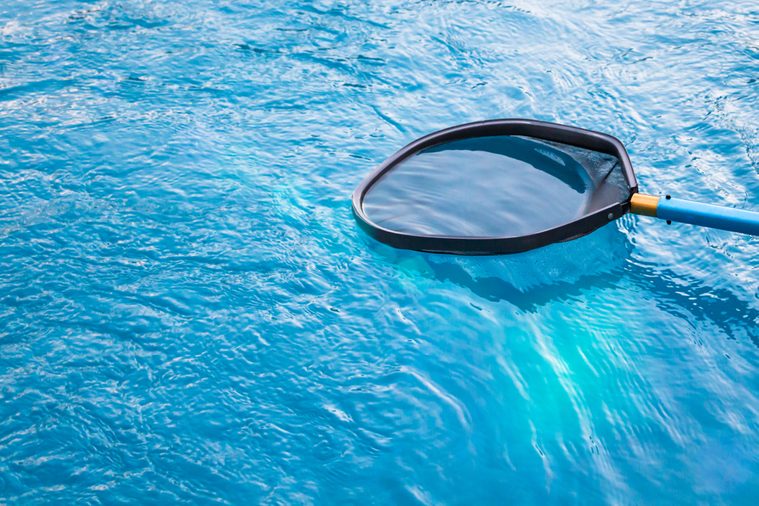
Poop in the pool
Disgusting, yes, but no poop is laughing matter—and be aware that you won’t always be able to see the contamination. “A common germ that spreads from diarrhea in the pool is the parasite called Cryptosporidium, or Crypto,” says Michele Hlavsa, chief of CDC’s Healthy Swimming Program. “A swimmer infected with Crypto can release 10 to 100 million germs into the water, and swallowing just 10 or fewer Crypto germs can make a person sick.” According to a recent CDC report, outbreaks from germs including Crypto have made more than 27,000 people sick in the last 15 years. In short: Don’t swallow the water. And no one should be swimming if they’ve had diarrhea. In addition, “take kids on hourly bathroom breaks to reduce the chance of poop in the water,” Hlavsa says. “For young children, check diapers every 30 to 60 minutes, and change diapers in a diaper-changing area, away from the water.” Read about other summer health dangers you’re probably avoiding.
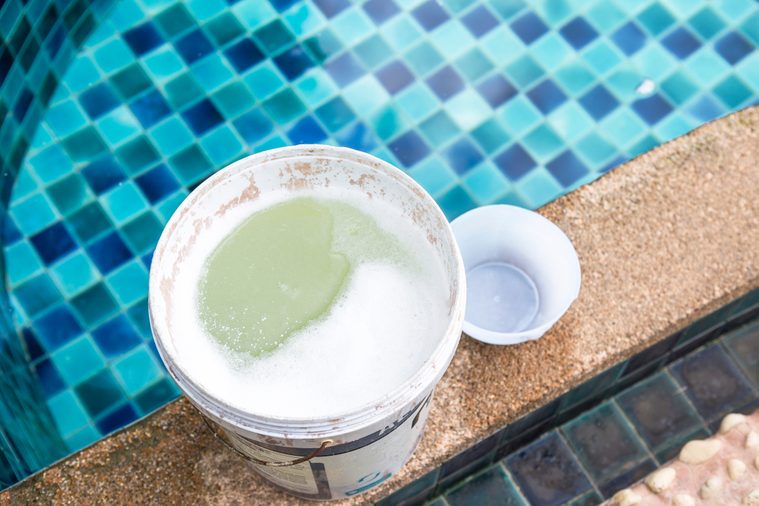
Chlorine effects
Chlorine is supposed to keep the pool clean, chlorine alone is not enough to keep you safe, and when it gets combined with dirt, sweat, or pee it can actually be a hazard. “Urine and dirt mix with chlorine, which uses up the chlorine so there is less available to kill harmful germs,” Hlavsa says. In addition, “urine and dirt mixed with chlorine produces chloramines, which can irritate the eyes, giving swimmers red eye.” It’s not the chlorine itself that makes your eyes red—it’s these disinfection by-products (DBPs). This is also the reason chloronated pools smell the way they do. “Chloramines, an example of disinfection by-products, not only irritate the eyes, they can also irritate the respiratory tract and trigger asthma attacks,” Hlavsa says. Shower before entering the water (as little as one minute is sufficient) to rinse off grime, and for goodness sake, don’t pee in the pool!

Respiratory illnesses
One of the most common recreational water illnesses (RWIs) is the bacterial infection Legionnaire’s disease, a type of pneumonia not spread from person to person. “People can get sick when they breathe in aerosolized water droplets or mists, like those made by hot tub jets, that contain Legionella [bacteria],” Hlavsa says. “Legionella can cause Legionnaires’ disease, a severe pneumonia, and Pontiac fever, a mild flu-like illness without pneumonia.” To avoid these, check inspection scores of your local public and hotel pools. Or carry test strips with you, and make sure the pool or hot tub you’re about to get into has the correct disinfectant and pH levels. Here are even more reasons why your relaxing hot tub is actually pretty gross.
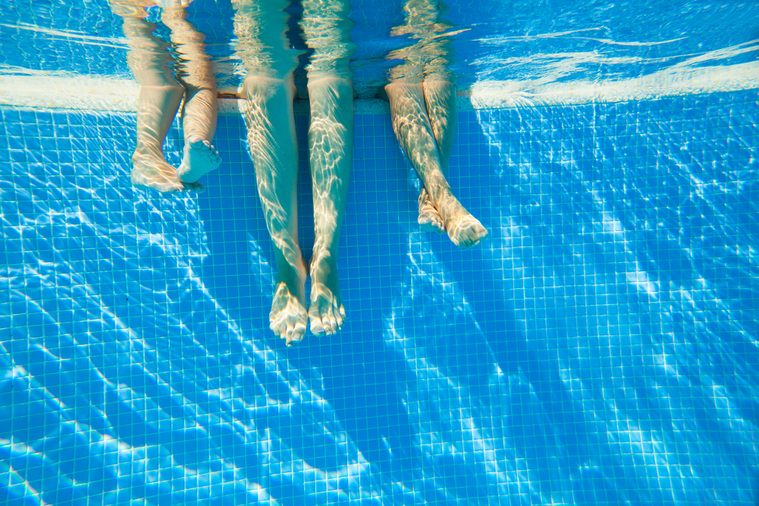
Athlete’s foot
It’s not just athletes who get this fungal infection from locker rooms—it’s recreational swimmers, too. “Athlete’s foot is an infection of the skin and feet caused by fungi that might be in damp areas such as showers, locker rooms, and swimming pools,” Hlavsa says. “To prevent athlete’s foot, clip nails short and keep them clean because nails can house and spread the infection. Also, avoid walking barefoot in locker rooms or public showers.” Keep those flip-flops or sandals on!
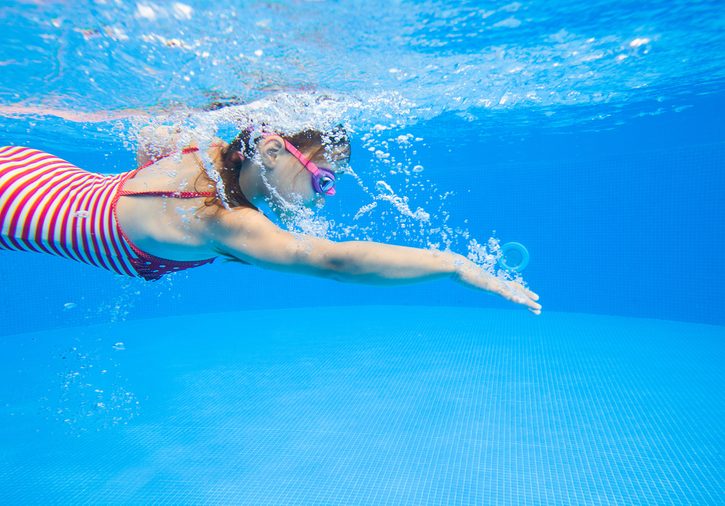
Swimmer’s ear
You know that annoying “water in your ear” sensation you sometimes get after swimming? Make sure you dry your ears thoroughly after getting out of the water. Here’s how to get water out of your ears. Why is this important? “Pseudomonas is a bacteria that can cause a skin infection, commonly called ‘hot tub rash,’ and an outer ear infection, commonly called ‘swimmer’s ear,'” Hlavsa says. “If a swimming venue does not maintain proper cleaning practices and disinfectant levels, these bacteria can grow on wet surfaces of pools, hot tubs, or water playgrounds and form biofilms—a slimy film made up of bacteria and their excretions.” That’s something that you really don’t want lingering in your ears. Again, you can check posted inspection scores or do your own inspection using test strips.
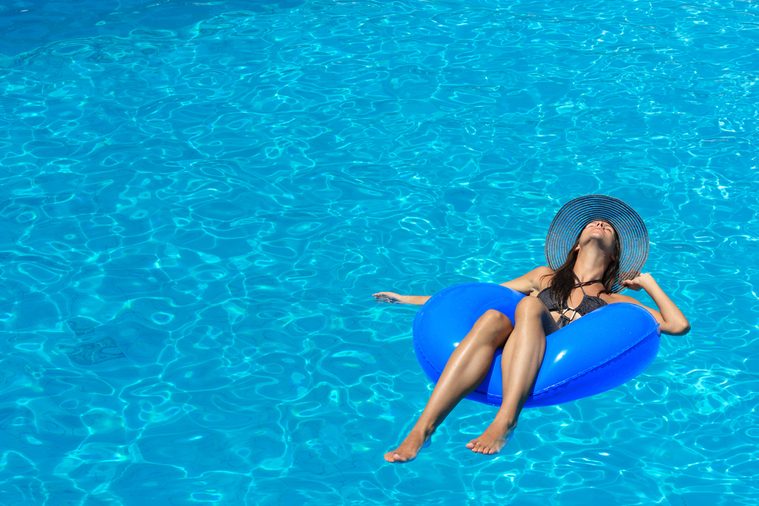
Hotel pools
A CDC recent report found one in three swimming-related disease outbreaks occured at a hotel, so use caution when you’re on vacation. Although hotels were the biggest offenders, public parks, clubs and recreational facilities, and water parks were also culprits. “Regardless of the venue, it’s easy to underestimate how hard it can be to correctly operate a pool and maintain disinfectant levels, including chlorine and bromine, and pH, which determine how effective the disinfectant kills germs,” Hlavsa says. “It’s important that operators successfully complete an operator training course approved by the health department, or that a responsible supervisor can do water testing, maintain water quality, and know when to close a pool to protect public health.” If you’ve got test strips in hand and are ready to brave it, here are the coolest kid-friendly hotels around the world.

